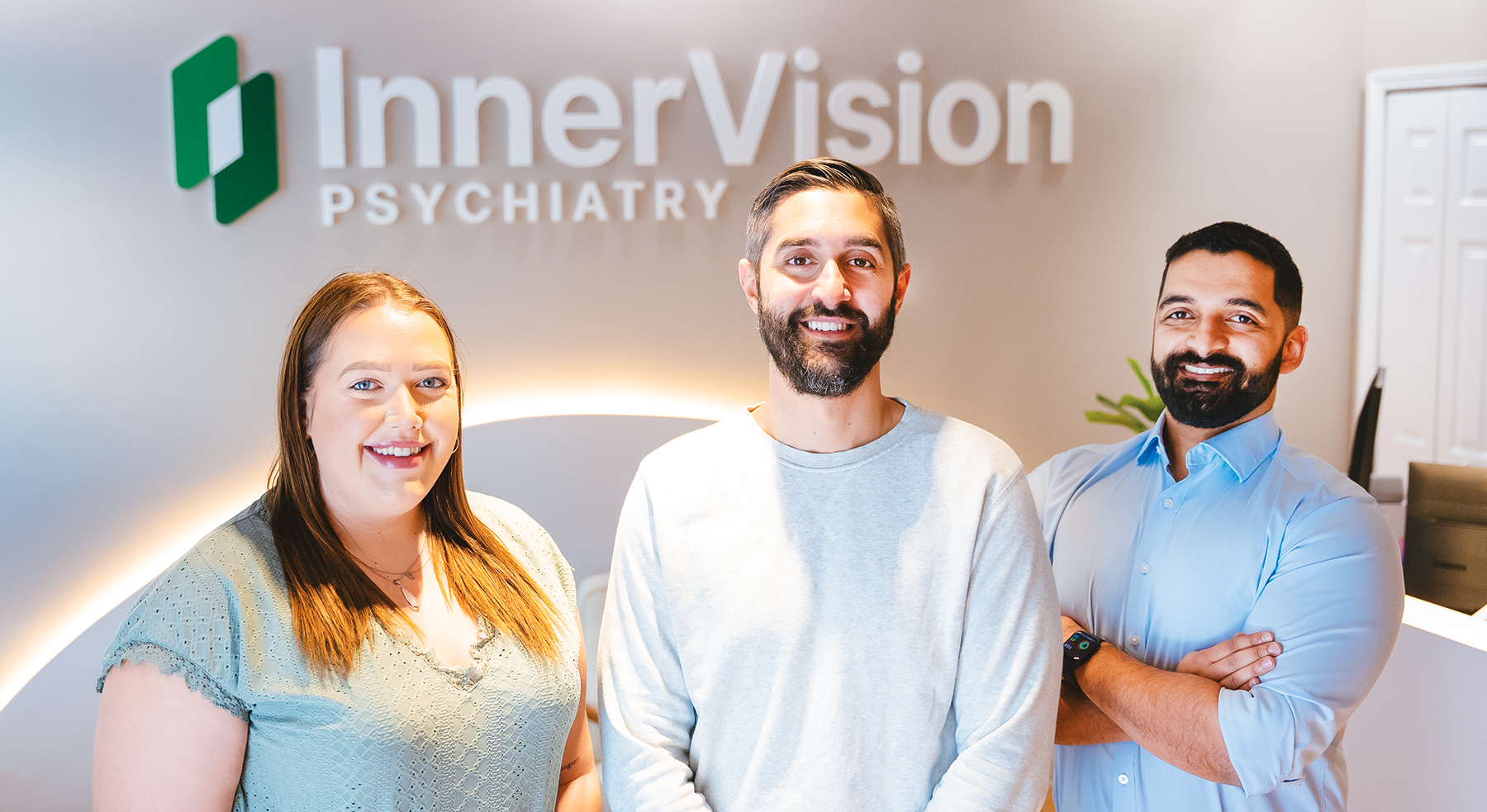
Professional Center behind Sam’s Club north of S.R. 56 in Wesley Chapel. (Photos by Charmaine George)
Isn’t it frustrating to feel like you’re out of options or settling for an incomplete solution to a problem? Many people with treatment- resistant anxiety, depression, or post-traumatic stress disorder (PTSD) are in that boat. However, Drs. Simon Chamakalayil and Joseph Pullara of InnerVision Psychiatry, in the Summergate Professional Center behind Sam’s Club in Wesley Chapel, may be able to offer these patients another treatment option — Ketamine.
What’s Exciting About Ketamine?
Ketamine was approved in 1970 by the U.S. Food & Drug Administration (FDA) as a general anesthetic, but also has been used off- label (without formal approval yet from the FDA) for short-term pain relief and sedation, chronic pain management and migraines. In recent years, Ketamine has been increasingly studied for use in patients with psychiatric conditions, such as anxiety, depression, PTSD and even suicidal ideation.
The exact way that Ketamine works to help patients with psychiatric conditions is not completely understood, but it is believed to be related to the drug’s psychedelic properties, which can cause feelings of detachment or disconnectedness. Since this is a new treatment approach, it can be helpful in patients who did not receive enough relief from more traditional treatments.
Unfortunately, because Ketamine has been available for more than 50 years, it is no longer protected by a patent and can be sold by any pharmaceutical company. This greatly reduces the potential profit that a pharmaceutical company can make off of Ketamine, even for a new use, and has eliminated those companies’ incentives to pursue the large- scale clinical trials required to submit for and receive FDA approval for Ketamine as a psychiatric treatment.
In 2019, Janssen Pharmaceuticals did successfully get FDA approval for one form of Ketamine called Esketamine, under the brand name Sparavato®. While this helped legitimize the use of Ketamine for psychiatric conditions, Esketamine was only FDA approved for treatment-resistant depression and depressive symptoms in adults who have acute suicidal ideation or behavior. Also, it is only available as a nasal spray that must be given under the supervision of a healthcare provider.
But thankfully, barriers for pharmaceutical companies do not stop independent research. In fact, it was while reading promising findings about Ketamine in medical journals when Dr. Pullara first became interested in Ketamine.
Is Ketamine safer than other anti-depressants or anti-anxiety/PTSD medications? It, like other psychiatric drugs, has side effects and potential for abuse if used in high (more than medically required) doses. Drs. Chamakalayil and Pullara are aware of this and take measures to minimize these issues.
As both doctors explain in a variety of posts and videos on Facebook, Instagram and other social media platforms, they use only low-dose Ketamine in their clinic, as that is the dosing that was mainly studied and supported by the medical community. In order to ensure patient safety and deter potential abuse, they only give Ketamine by intravenous (IV) infusions in their clinic under healthcare provider supervision, as opposed to oral Ketamine that could be given at home. “Monitoring is important,” says Dr. Pullara. “We don’t support at-home or oral Ketamine because it can be risky without monitoring.”
He adds that many of the main side effects of Ketamine — including nausea, vomiting, dizziness, drowsiness and increased heart rate and blood pressure — are often temporary and can be monitored and improved upon by adjusting the infusion rate.
A plus for IV Ketamine therapy for anxiety, depression and PTSD treatments is that it does not need to be given every day. The initial treatment — aka, the loading doses — are usually six doses over a two-week period. After that, if the Ketamine is helping, the patient will continue on maintenance treatment, which is based on managing symptoms.
Dr. Chamakalayil explains on InnerVisionPsychiatry.com that after completing the initial six treatments, they recommend bi-weekly treatments for the following month. After that, the frequency depends upon each patient’s need, ranging from every other week or monthly, every two to three months, or even every six months.
Perhaps the best part is that patients can experience an improvement in their symptoms much faster than they can using older treatment options.
“Ketamine works more quickly and differently than traditional anti-depressants,” says Dr. Chamakalayil. “With other drugs, it usually takes at least four weeks just to see an effect. With Ketamine, you can see a benefit within a few days to the first week.”
The Matthew & Maya Cases
There have been a few public cases in which Ketamine has been associated with bad outcomes, such as with “Friends” star Matthew Perry and locally, with Maya Kowalski.
Maya Kowalski did not suffer harm from Ketamine, but her healthcare team was concerned about her Ketamine use at a young age, and at her mother’s insistence. However, they initially did not know that Maya has a rare disease called Complex Regional Pain Syndrome (CRPS) and Ketamine was medically prescribed at higher doses to manage her pain. As stated earlier, for psychiatric conditions, only low-dose Ketamine is recommended.
Maya’s mother Beata ultimately committed suicide herself when doctors at All Children’s Hospital in Tampa feared she was abusing her daughter. The Kowalski family successfully sued the hospital in the now- famous “Take Care of Maya” case, which will reportedly be appealed to a higher court.
As for the unfortunate death of Matthew Perry, the doctors explain the circumstances behind his Ketamine use.
“By now, we have all seen the headlines… “Matthew Perry died of the ‘acute effects of Ketamine,’” says Dr. Pullara. “The level of Ketamine found in his system was consistent with that of someone undergoing high-dose anesthesia. These high doses, combined with the sedative effects of buprenorphine, lorazepam and clonazepam found in his system, put him at a significant risk of sedation and respiratory depression. This is why the autopsy listed drowning as a ‘contributing factor’ in his death.”
He adds, “It was reported that Matthew was indeed undergoing IV Ketamine infusions for depression, similar to those offered at InnerVision Psychiatry. But his last infusion was about 1.5 weeks before his death, and as the autopsy report itself points out, the Ketamine in his system ‘could not be from that infusion therapy, since Ketamine’s half-life (time required for 50% of the drug to be eliminated by the body) is 3 to 4 hours or less.”
The Doctors Behind InnerVision
Dr. Pullara was born and raised in Lutz. After completing a Bachelor of Science (B.S.) degree in Biological Sciences at Florida State University in Tallahassee, he attended medical school at the American University of the Caribbean in St. Maarten and received his Doctor of Medicine (M.D.) degree in 2015.
Dr. Pullara’s dedication to research-guided treatment advances led him to co-found The Journal of Psychedelic Psychiatry with some of his colleagues during his four-year psychiatry residency at the University of Kansas in Kansas City, MO, where he also served as chief resident. He currently serves as one of TheJournal’s deputy editors.

After finishing his residency in 2020, Dr. Pullara returned to Florida and began working at Lakeland Regional Hospital as a psychiatrist, where he met Dr. Chamakalayil, who was similarly interested in Ketamine for use in his psychiatric patient population.
Dr. Chamakalayil completed a combined BS/MD program in 2015 at the Drexel University College of Medicine in Philadelphia, PA. Afterwards, he was a general psychiatry resident at Temple University Hospital, also in Philadelphia, where he also served as chief resident.
Discovering a passion for helping children and adolescents, Dr. Chamakalayil obtained further specialization in child and adolescent psychiatry by completing a two-year fellowship at MedStar Georgetown University Hospital in Washington, DC, where he served as clinical chief fellow, in 2021. After completing his training, Dr. Chamakalayil relocated to central Florida to work at Lakeland Regional Hospital.
While working at the hospital together, both doctors saw difficult cases of patients requiring hospital admission for psychiatric care — and experienced exciting success when using Ketamine to treat these patients.
Dr. Pullara, who eventually moved from Lakeland to Wesley Chapel with his wife and two children, felt strongly that patients in his hometown area shouldn’t have to travel all the way to Tampa or Clearwater for psychiatrist- led Ketamine treatment.
Looking To The Future
Together, the doctors opened InnerVision Psychiatry in Wesley Chapel in November of 2021, becoming the first clinic offering IV Ketamine infusions for anxiety, depression and PTSD in Pasco County.
Converting a former Sylvan Learning Center location from the bottom up, they creating a tranquil, state-of-the-art facility for their patients. Working with their office manager Amanda Thompson and a team of four nurses, the clinic is open by appointment only during the weekdays to offer Ketamine infusions.
All patients must complete a screening form to ensure that they are good candidates for Ketamine treatment. It’s important to note that InnerVision does not treat pain, so any patients looking for Ketamine for pain relief are referred to pain management providers.
The doctors do not believe in a quick, walk-in treatment approach. They always provide a one-hour consultation to new patients to learn their treatment and medication histories and the symptoms they are experiencing before starting Ketamine treatment. If necessary, they will touch base with a patient’s primary care provider and psychiatrist. Then, on each appointment day, there is a pre- and post-treatment check-in to make sure patients are comfortable and feeling well before and after receiving Ketamine.
Even though the office just hosted a ribbon cutting event in January, the doctors estimate that they’ve already helped about 50 patients. Even better is that they’ve already heard great feedback from several of those patients.
One of Dr. Chamakalayil’s first patients at InnerVision was struggling with severe anxiety and PTSD since childhood. Like all of the clinic’s patients, this patient had already tried several different treatment options in the past and was therefore diagnosed with treatment- resistant disease.
After receiving the loading dose Ketamine treatments, Dr. Chamakalayil recalls that the patient said, “This is the calmest I’ve felt in my entire life. Now I understand what calm means.”
Later, after completing the loading doses, the patient provided an update. With the guidance of the patient’s psychiatrist, the patient stopped taking the two oral anti-depressants that the patient was previously taking. In the patient’s own words, “Ketamine saved my life.”
Right now, the doctors are focusing on Ketamine infusions. But, they believe strongly in evidence-based medicine and are keeping up with the latest research on other psychedelics. They are hopeful about offering patients new treatment options for difficult to treat psychiatric diseases in the coming years.
“There are promising clinical trials for mi- domafetamine or MDMA (the active ingredient in the street drug ecstasy) in PTSD treatment,” says Dr. Pullara. “It’s possible that by the end of this year, MDMA could receive FDA approval. Currently, there are only two FDA-approved treatments (for PTSD), so this would be the third. We would be interested in providing MDMA treatment to patients upon FDA ap- proval and the release of more research data.”
Dr. Chamakalayil also is looking to make a change. His family is still living in Lakeland for now, but they hope to make the move to Wesley Chapel soon, so they can be closer to the clinic— especially since he and his wife are expecting to welcome their first child in May.
InnerVision Psychiatry is located at 27774 Cashford Cir., Suite 102. The clinic is open by appointment only, Mon.- Fri., 9 a.m.–5 p.m. For more info, call (813) 428-5420, visit InnerVisionPsychiatry.com. The website also has links to the clinic’s social media pages, which are regularly updated with easy-to-follow, informative posts and videos.




No comment yet, add your voice below!